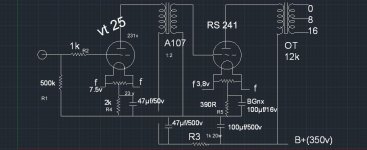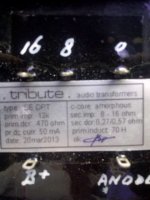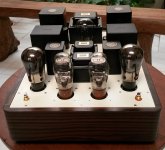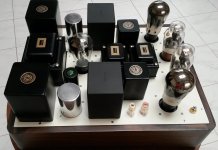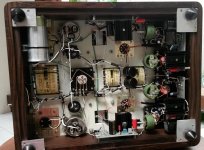hi Edy,
We can help you choose, but you must choose some important features of your design first.
1. What is your expectation of output power? The RS241 is capable of operating with grid positive (class A2). this will give more power, but you will need a FET source-follower, or a high-gm cathode follower to provide the current required into the grid. A2 also means the driver must be able to supply higher [ac] signal voltage.
2. When you have decided about A2, you can draw the load line for your transformer, knowing the impedance that the transformer and speaker combination presents to the RS241.
3. The load line confirms the grid bias voltage you need, and the operating point (eg Va=400V, Ia=30mA, bias= -15V. In this case the driver only needs to swing about 35V or so, peak to peak - class A1, and a little more for class A2 (if required).
4. Finally, what's the output of you preamp or DAC? With this value, you can identify the required gain. This will have a strong influence on what kind of driver to choose.
We can help you choose, but you must choose some important features of your design first.
1. What is your expectation of output power? The RS241 is capable of operating with grid positive (class A2). this will give more power, but you will need a FET source-follower, or a high-gm cathode follower to provide the current required into the grid. A2 also means the driver must be able to supply higher [ac] signal voltage.
2. When you have decided about A2, you can draw the load line for your transformer, knowing the impedance that the transformer and speaker combination presents to the RS241.
3. The load line confirms the grid bias voltage you need, and the operating point (eg Va=400V, Ia=30mA, bias= -15V. In this case the driver only needs to swing about 35V or so, peak to peak - class A1, and a little more for class A2 (if required).
4. Finally, what's the output of you preamp or DAC? With this value, you can identify the required gain. This will have a strong influence on what kind of driver to choose.
hi Edy,
We can help you choose, but you must choose some important features of your design first.
1. What is your expectation of output power? The RS241 is capable of operating with grid positive (class A2). this will give more power, but you will need a FET source-follower, or a high-gm cathode follower to provide the current required into the grid. A2 also means the driver must be able to supply higher [ac] signal voltage.
2. When you have decided about A2, you can draw the load line for your transformer, knowing the impedance that the transformer and speaker combination presents to the RS241.
3. The load line confirms the grid bias voltage you need, and the operating point (eg Va=400V, Ia=30mA, bias= -15V. In this case the driver only needs to swing about 35V or so, peak to peak - class A1, and a little more for class A2 (if required).
4. Finally, what's the output of you preamp or DAC? With this value, you can identify the required gain. This will have a strong influence on what kind of driver to choose.
Hi Coleman,
thank you for your help.
I've tried to make it.
using the circuit the commond cathode SE with auto bias
My reference circuit VT52. but by using the VT25 as a driver, not 71.
but I am not sure what is true.
I do not know what is enough, the driver sends to the grid voltage swing.
my preamp cleo triode dick B406 parafeed with OTL 10K:600 little gain. and amplification.
have given the chart .
Attachments
Hi Edy,
Do you have a 12K transformer? It will be high cost, for good quality.
The bias voltage is probably 12V or less for the RS241. This means, the RS241 grid needs about 30V peak-peak for full power (= 10.6V rms). Maybe a little less will suffice, but assume you need this.
The interstage transformer is 1:2 so with 10Y or VT-25 you will need about 1 - 3Vrms from the preamp, depending on the exact transformers and bias settings.
It's probably OK, but the outcome will depend on the transformers you can use. But a DHT should be possible - no need to use a pentode.
I hope you have high efficiency speakers - the output from the RS241 will only be 2-3W or so.
Do you have a 12K transformer? It will be high cost, for good quality.
The bias voltage is probably 12V or less for the RS241. This means, the RS241 grid needs about 30V peak-peak for full power (= 10.6V rms). Maybe a little less will suffice, but assume you need this.
The interstage transformer is 1:2 so with 10Y or VT-25 you will need about 1 - 3Vrms from the preamp, depending on the exact transformers and bias settings.
It's probably OK, but the outcome will depend on the transformers you can use. But a DHT should be possible - no need to use a pentode.
I hope you have high efficiency speakers - the output from the RS241 will only be 2-3W or so.
Hi Edy,
Do you have a 12K transformer? It will be high cost, for good quality.
The bias voltage is probably 12V or less for the RS241. This means, the RS241 grid needs about 30V peak-peak for full power (= 10.6V rms). Maybe a little less will suffice, but assume you need this.
The interstage transformer is 1:2 so with 10Y or VT-25 you will need about 1 - 3Vrms from the preamp, depending on the exact transformers and bias settings.
It's probably OK, but the outcome will depend on the transformers you can use. But a DHT should be possible - no need to use a pentode.
I hope you have high efficiency speakers - the output from the RS241 will only be 2-3W or so.
Hi Rod,
thank you for your advise.
I have OT Tribute 12K from Pieter.
I've tried to build ,my Power Rs241 dan driver VT25.
Rectifire RGN 4004
Transformer Hashimoto.
Attachments
Last edited:
Hi Pak Suwaned, I am interested to build amplifier with RS241 too. I live in Jakarta. Is there a number I can contact you?
Hi Uran. Your are well come. I will contact to you soon.
I will share with you from my project rs241 experience .
Thank's
Anybody tried RE084-RE134-RS241 SE Amps?
Hi Jonah.
How are you with your RS241?
I haven't tried there. But my friend have tried whit RE106.
regards
Hi Jonah.
How are you with your RS241?
QUOTE]
Well, I am still working on it. Hope to finish within this year..
In my experience VT25 and RS241 are not good partner.
I guess thoriated tungsten filament and oxide coated filament tonal character are too different and have poor synergy.
Sound was lacking the nuances both the tubes are able to give at their best.
In fact VT25A + RS241 amp, worked way better.
VT25A has oxide coated filament and its lower internal impedance helps driving the RS241.
If you are willing to give noval heater tubes a try, I would suggest triode connected E180F or E810F.
I guess thoriated tungsten filament and oxide coated filament tonal character are too different and have poor synergy.
Sound was lacking the nuances both the tubes are able to give at their best.
In fact VT25A + RS241 amp, worked way better.
VT25A has oxide coated filament and its lower internal impedance helps driving the RS241.
If you are willing to give noval heater tubes a try, I would suggest triode connected E180F or E810F.
RS241 transformer coupled to a second RS241 was also a very good sounding solution.
hi,
like Henry HV755 , couple RS241....
i ever tried RS241 for preamp.... impressive ..
Low to high could well appear there.
I have uploaded RS241 with my Garrard 401 new plinth on youtube.
and i want you can give opinion if you compare with my 300B version HQ-DHT Amli.
https://www.youtube.com/watch?v=wk7susQlmCI
https://www.youtube.com/watch?v=6xnVvwMmJnE
regards
In my experience VT25 and RS241 are not good partner.
I guess thoriated tungsten filament and oxide coated filament tonal character are too different and have poor synergy.
Sound was lacking the nuances both the tubes are able to give at their best.
??
He can flip the phase at the interstage so that the distortion products either add or subtract.
Besides, I like TT fil input DHT to oxide coated OP or driver. Gross generalisations mean little.
Sun.
??
He can flip the phase at the interstage so that the distortion products either add or subtract.
Besides, I like TT fil input DHT to oxide coated OP or driver. Gross generalisations mean little.
Sun.
Hi Sun.
How about you experienced with that?
You give IT between they.
Regards
Ed
Hi,
Yes.
Each plate loaded stage is counter phase to the next, so there is some cancellation of distortion products. With the interstage, you have the capability to inverse the secondary so that the two stages are in phase and the distortion products will then add.
There is also a changing of interaction between the two tube stages under dynamic conditions (via the interstage), so the most simple thing is to simply reverse the secondary connections and see which you prefer.
Sun Tzu.
Yes.
Each plate loaded stage is counter phase to the next, so there is some cancellation of distortion products. With the interstage, you have the capability to inverse the secondary so that the two stages are in phase and the distortion products will then add.
There is also a changing of interaction between the two tube stages under dynamic conditions (via the interstage), so the most simple thing is to simply reverse the secondary connections and see which you prefer.
Sun Tzu.
Hi,
Yes.
Each plate loaded stage is counter phase to the next, so there is some cancellation of distortion products. With the interstage, you have the capability to inverse the secondary so that the two stages are in phase and the distortion products will then add.
There is also a changing of interaction between the two tube stages under dynamic conditions (via the interstage), so the most simple thing is to simply reverse the secondary connections and see which you prefer.
Sun Tzu.
Hi Tsu,
if our know output from final to speaker is invert phase, how connection to binding post of speaker?
+ to + /- to - .................. or ............ + to - / - to + ( for correction phase)
regards
- Status
- This old topic is closed. If you want to reopen this topic, contact a moderator using the "Report Post" button.
- Home
- Amplifiers
- Tubes / Valves
- choice of driver for RS 241
